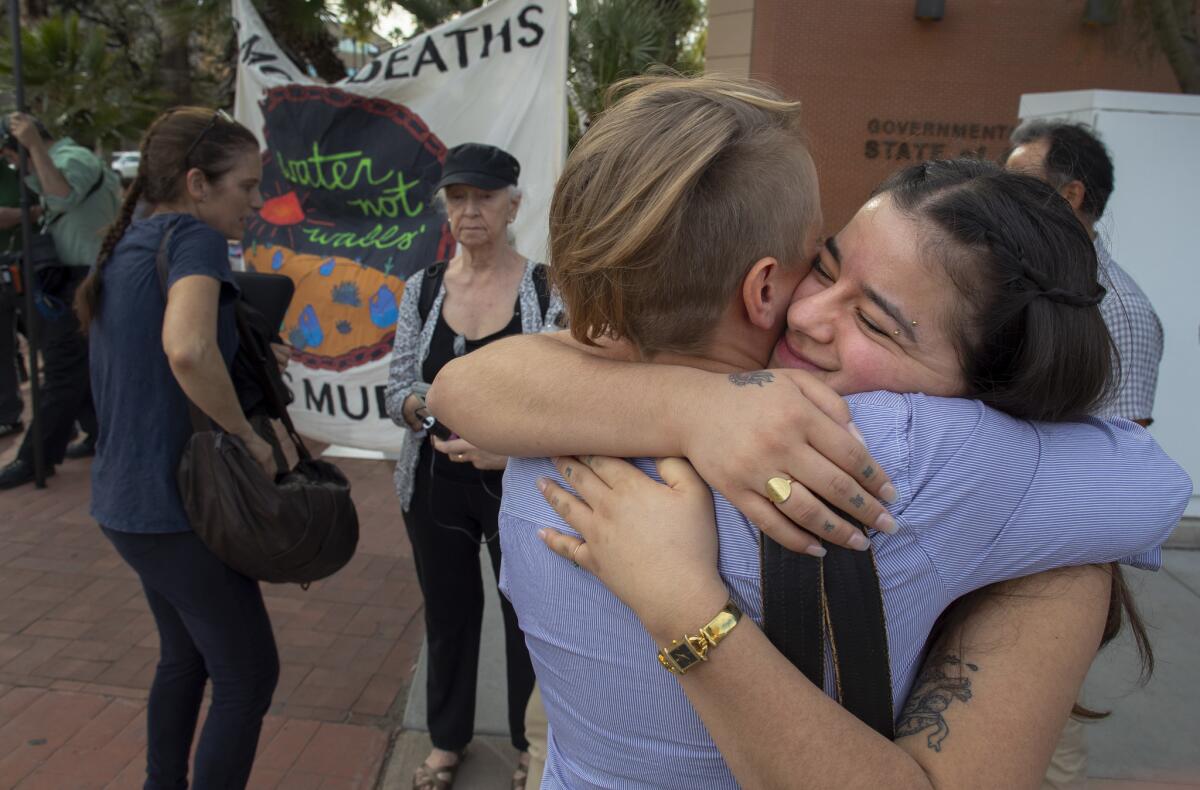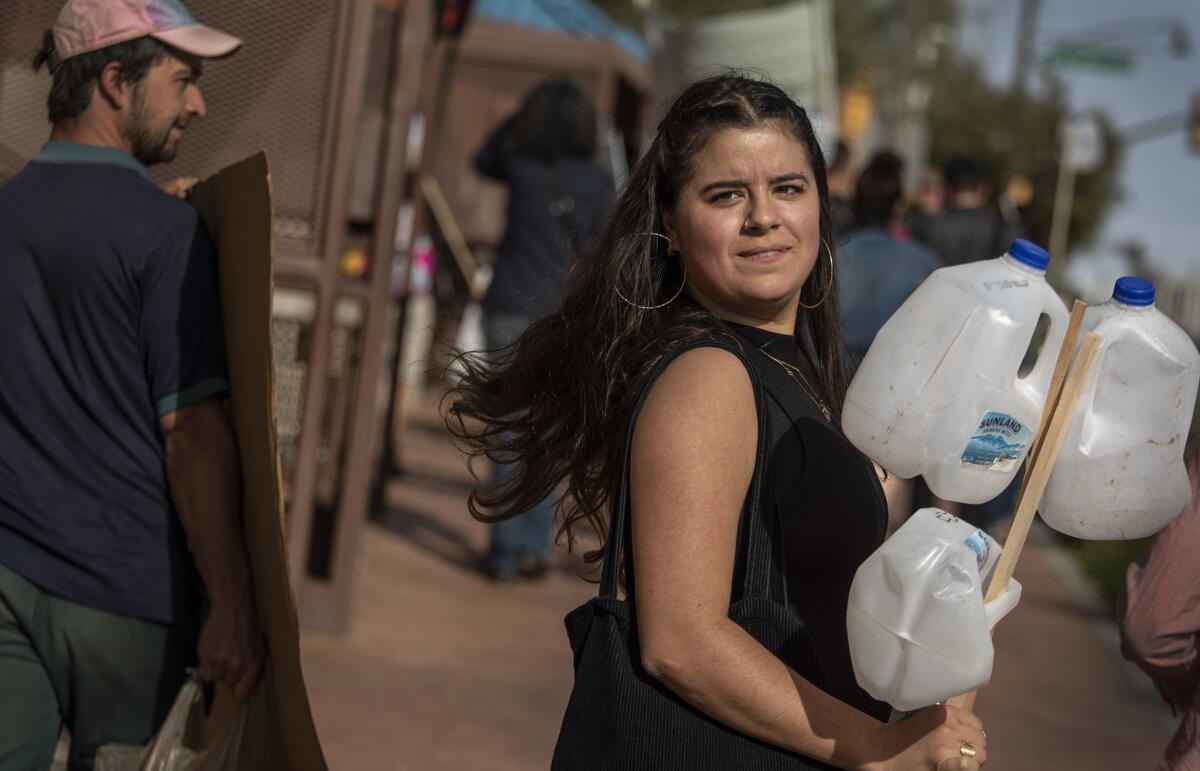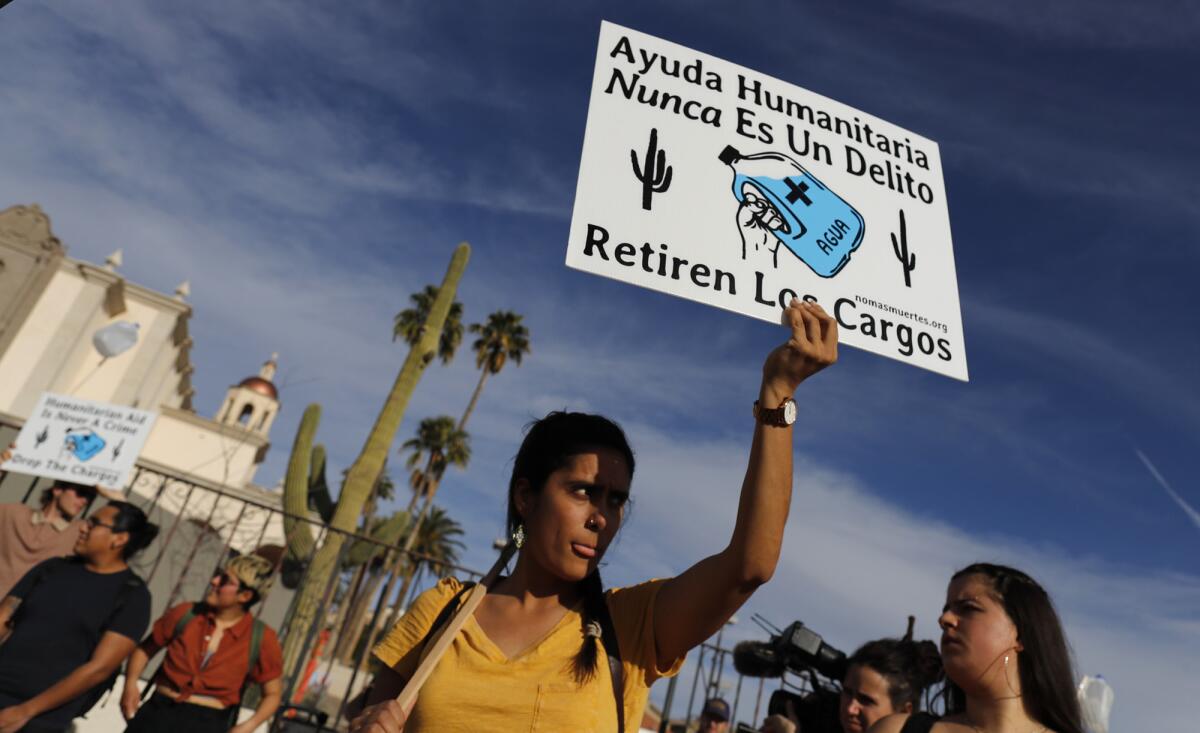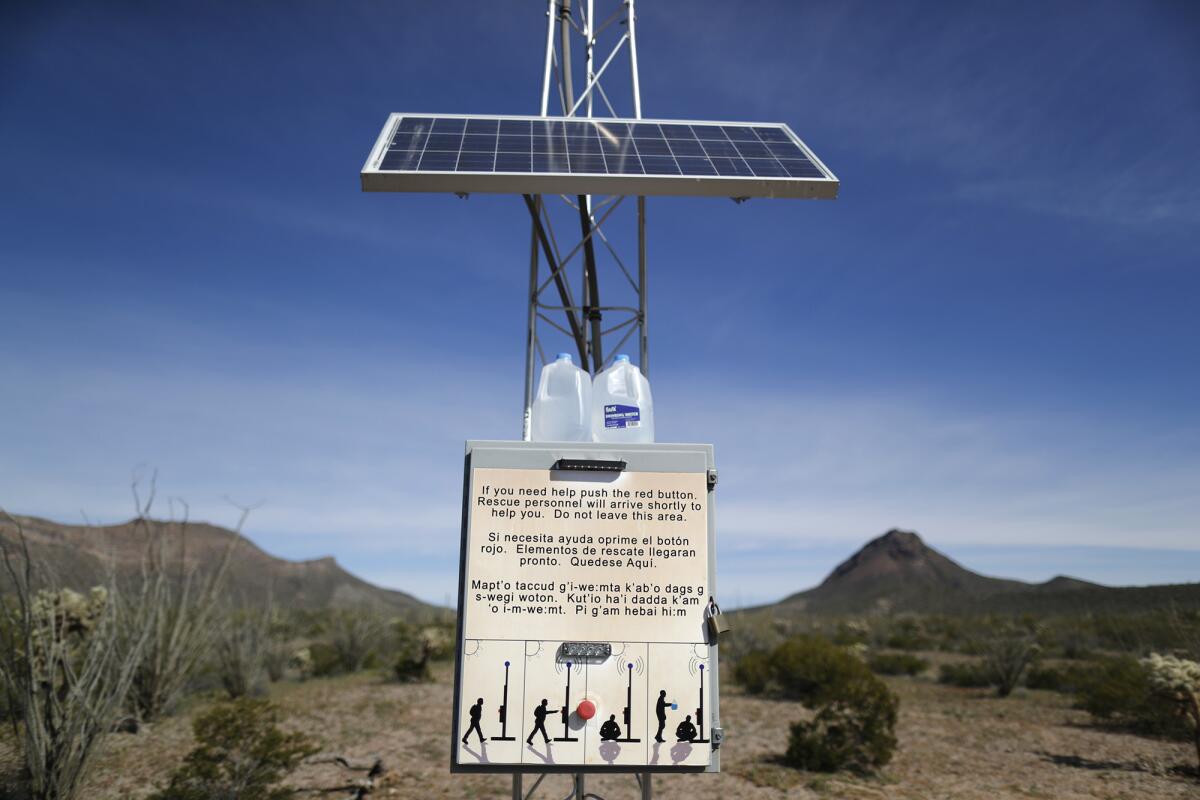Should activists aid migrants in the desert, or leave their fate to the Border Patrol?

Reporting from Cabeza Prieta, Ariz. — Four young women, volunteers from a local migrant aid group, appeared before a federal judge for sentencing in Tucson last week. Their crime: leaving jugs of water, food and other supplies in a desolate desert refuge 130 miles west to protect the lives of migrants illegally crossing the Mexican border.
In January, the four members of No More Deaths had been convicted of trespassing in the sprawling Cabeza Prieta National Wildlife Refuge. They each faced up to six months in prison and a $5,000 fine. Instead, following an impassioned hearing, they received relatively minor sentences of 15 months’ unsupervised probation and a $250 fine.
For the record:
9:45 a.m. March 8, 2019An earlier version of this article misstated how many activists had their charges downgraded. Four, not five, had charges reduced.
The case raises significant questions about whether the Border Patrol provides migrants in peril with sufficient assistance when the Trump administration is making every effort to prevent asylum seekers from reaching border crossings.
The women’s attorney, Chris Dupont, told the judge that they were only trying to fill a humanitarian void left by the Border Patrol, which Dupont said does not do enough to save migrants in peril. There isn’t cellphone service in much of Cabeza Prieta, and Border Patrol rescue beacons are thousands of square miles apart and particularly difficult to see during daylight, he said. Between 2001 and 2018, remains of 137 people were found in the desert corridor, according to the Pima County Medical Examiner.
“That’s why they’re out there: to save people like that,” Dupont told the courtroom packed with supporters. “People continue to suffer and die in the desert.”
Federal prosecutor Anna Wright countered that the volunteers enabled smugglers. She said humanitarian aid should be left to the Border Patrol, which created a network of 34 rescue beacons in the Tucson sector that includes Cabeza Prieta. The beacons help save lives, she said, because migrants are provided the aid when they turn themselves in or are caught.

Before sentencing the volunteers, U.S. Magistrate Judge Bernardo Velasco said their efforts, “however laudable,” broke the law, and the case needed to send that message. “I hope you’re not going to do it again,” the judge said.
The defendants looked relieved, and supporters in the gallery smiled.
Prosecutors later released a statement saying they intended to continue to charge those who commit similar offenses.
In recent weeks, Border Patrol agents have reported hundreds of migrant children and families seeking asylum together at remote desert crossings in Arizona, New Mexico and Texas. In recent weeks, agents in the Cabeza Prieta area saw a group of 325 migrants turn themselves in. Border-wide, 76,103 migrants were detained last month, a 12-year record, 42,999 of them families and children.
Since the women and five other No More Deaths volunteers were charged last year, supporters had mounted a legal aid campaign to defend the group, dubbed the “Cabeza 9,” and posted signs around town proclaiming “Humanitarian Aid is Not a Crime. Drop the Charges.” The day of the sentencing, they paid for a full-page ad in the Arizona Daily Star signed by hundreds of other aid groups from across the country saying, “We stand with No More Deaths.”
The women’s attorneys insisted the Border Patrol’s method of providing aid has failed, and that the criminal charges were retaliation after the group released videos showing border agents destroying jugs of water and other supplies they had left in the desert.

Protesters march in support of migrant aid group volunteers, who appeared before a federal judge last week for trespassing along the border with Mexico, where they left supplies for migrants entering the U.S. illegally.
No More Deaths has attracted volunteers from across the country since its founding in 2004. It has eight staff members and up to 60 regular volunteers.
John Fife, a retired Presbyterian minister, helped found the group after becoming active in the sanctuary movement in the 1980s. Back then, he and other volunteers escorted Central American migrants fleeing death squads through the deserts of northern Mexico to the border.
In 1986, Fife and seven other volunteers were convicted of violating federal immigration laws. Sentenced to five years’ probation, they continued to help migrants.
“We have every legal right to provide humanitarian aid in a human disaster like the thousands of deaths that have occurred out here in the Sonoran Desert,” said Fife, who has volunteered with some of those recently charged.
For years, No More Deaths volunteers felt they had an understanding with the Border Patrol. Agents rarely stopped them. That changed after President Trump was elected, volunteers said.
Agents started stopping volunteers regularly in Cabeza Prieta, a rugged 860,000-acre preserve including 56 miles of border next to Organ Pipe Cactus National Monument. As a result, tensions heightened.

“No More Deaths’ relationship with Border Patrol has never been completely peaceful,” said volunteer Parker Deighan, 28, of Tucson. “… But we have definitely seen an escalation the last few years.”
In June 2017, agents raided a No More Deaths migrant aid station in the desert. Later that summer, a U.S. Fish and Wildlife officer stopped four volunteers: Natalie Hoffman, 23, of Tucson; Oona Holcomb, 39, of St. Paul, Minn.; Madeline Huse, 23, of Bellingham, Wash.; and Zaachila Orozco-McCormick, 21, of Seattle. In December, they were charged as part of the Cabeza 9.
Deighan and four other volunteers were charged separately after trying to help three migrants. Two of the migrants were later detained, she said. One was never found.
On Jan. 17, 2018, No More Deaths released a report alleging Border Patrol had interfered with their work and videos showing Border Patrol agents destroying supplies they had left for migrants. Hours later, agents descended on the group’s facility near Cabeza Prieta, detained four migrants and charged volunteer Scott Warren with harboring and conspiracy. Scheduled for trial in May, Warren faces up to 20 years in prison if convicted.
The first four Cabeza 9 volunteers were convicted in January of entering the refuge without a permit and abandoning property (water jugs and beans). Recently, four other Cabeza 9 volunteers — including Deighan — had their charges downgraded to civil infractions and paid $250 fines. Warren still faces misdemeanor and felony charges.
As the volunteers left the courtroom last week, supporters applauded. Once outside, they marched through downtown hoisting empty water jugs from the desert and signs saying “Cabeza Prieta Wildlife Refuge and mass grave.” No More Deaths organizers said that instead of deterring volunteers, the Cabeza 9 cases have increased their commitment, and drawn new volunteers to help migrants.
Volunteer Paige Corich-Kleim, 28, of Tucson said the group has pressured the Border Patrol to release information showing rescue beacons work, to improve them and other efforts to save migrants.
“We want to make them as safe as possible so that they don’t die,” Corich-Kleim said.
On Monday, a rescue beacon in the Growler Valley near Cabeza Prieta’s Camino del Diablo (Devil’s Highway) had water jugs set on top of its base, a sign volunteers were still active in the area.
That’s not what Border Patrol Agent Dan Hernandez had wanted.
As Hernandez drove over rolling hills of saguaro and organ pipe cacti toward the south side of the refuge that borders Mexico, half a dozen migrants activated a beacon and were detained. An hour later, another migrant activated a second beacon. A third group of migrants — three fathers from Guatemala, each with a child — turned themselves in to agents about a hundred feet from a waist-high metal border fence. Bound for Florida and Texas, they had paid a smuggler $200 to steer them to the desert crossing, where they arrived without supplies.

Last year, the 34 beacons in the Tucson sector that includes Cabeza Prieta helped agents locate 138 migrants, fewer than in previous years, Hernandez said.
Seven of the beacons are equipped with satellite phones migrants can use to contact the Border Patrol. The rest, stationed in spots without clear satellite signals, have red buttons migrants push to alert the agency. They’re also equipped with day and night infrared cameras agents use to gauge migrants’ condition. If they appear seriously ill, Hernandez said, a paramedic agent can be sent by helicopter to treat and extract them.
The 30-foot towers cost about $3,000 and are movable. They’re crowned with reflectors that glow during the day and light up blue at night, a signal Hernandez said is visible for up to 10 miles. (No More Deaths volunteers insist some beacons are visible no more than 1,500 feet away.) Agents check the beacons daily, are adding brighter day lights and building new beacons 10 feet taller to make them more visible, Hernandez said.
He said the videos No More Deaths released of agents dumping water left for migrants gave the agency “a black eye.” If agents discover supplies left by volunteers, he said, they now know “don’t touch it.” But he said such aid “sends the wrong message: Continue your journey.”
“It defeats the purpose of the rescue beacon,” Hernandez said. “…We want them to press that button and end their journey. We don’t want them to grab a jug and walk to their deaths.”
More to Read
Sign up for Essential California
The most important California stories and recommendations in your inbox every morning.
You may occasionally receive promotional content from the Los Angeles Times.











